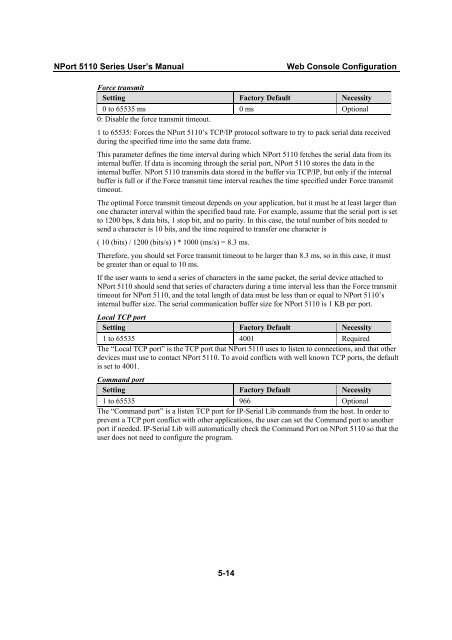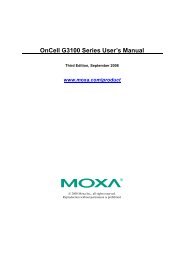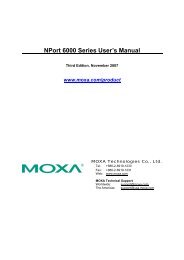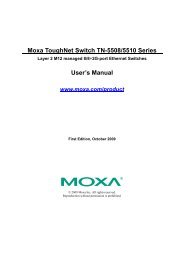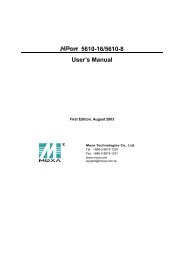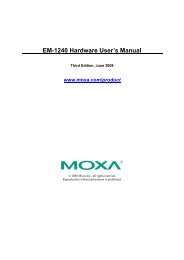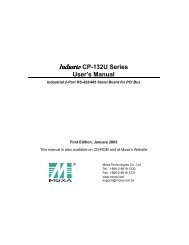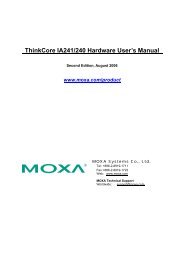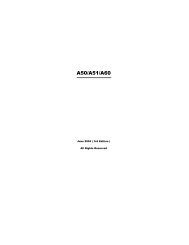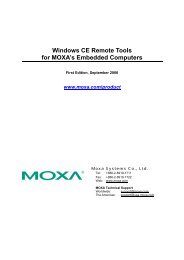NPort 5110 User's Manual - Moxa
NPort 5110 User's Manual - Moxa
NPort 5110 User's Manual - Moxa
Create successful ePaper yourself
Turn your PDF publications into a flip-book with our unique Google optimized e-Paper software.
<strong>NPort</strong> <strong>5110</strong> Series User’s <strong>Manual</strong> Web Console Configuration<br />
Force transmit<br />
Setting Factory Default Necessity<br />
0 to 65535 ms 0 ms Optional<br />
0: Disable the force transmit timeout.<br />
1 to 65535: Forces the <strong>NPort</strong> <strong>5110</strong>’s TCP/IP protocol software to try to pack serial data received<br />
during the specified time into the same data frame.<br />
This parameter defines the time interval during which <strong>NPort</strong> <strong>5110</strong> fetches the serial data from its<br />
internal buffer. If data is incoming through the serial port, <strong>NPort</strong> <strong>5110</strong> stores the data in the<br />
internal buffer. <strong>NPort</strong> <strong>5110</strong> transmits data stored in the buffer via TCP/IP, but only if the internal<br />
buffer is full or if the Force transmit time interval reaches the time specified under Force transmit<br />
timeout.<br />
The optimal Force transmit timeout depends on your application, but it must be at least larger than<br />
one character interval within the specified baud rate. For example, assume that the serial port is set<br />
to 1200 bps, 8 data bits, 1 stop bit, and no parity. In this case, the total number of bits needed to<br />
send a character is 10 bits, and the time required to transfer one character is<br />
( 10 (bits) / 1200 (bits/s) ) * 1000 (ms/s) = 8.3 ms.<br />
Therefore, you should set Force transmit timeout to be larger than 8.3 ms, so in this case, it must<br />
be greater than or equal to 10 ms.<br />
If the user wants to send a series of characters in the same packet, the serial device attached to<br />
<strong>NPort</strong> <strong>5110</strong> should send that series of characters during a time interval less than the Force transmit<br />
timeout for <strong>NPort</strong> <strong>5110</strong>, and the total length of data must be less than or equal to <strong>NPort</strong> <strong>5110</strong>’s<br />
internal buffer size. The serial communication buffer size for <strong>NPort</strong> <strong>5110</strong> is 1 KB per port.<br />
Local TCP port<br />
Setting Factory Default Necessity<br />
1 to 65535 4001 Required<br />
The “Local TCP port” is the TCP port that <strong>NPort</strong> <strong>5110</strong> uses to listen to connections, and that other<br />
devices must use to contact <strong>NPort</strong> <strong>5110</strong>. To avoid conflicts with well known TCP ports, the default<br />
is set to 4001.<br />
Command port<br />
Setting Factory Default Necessity<br />
1 to 65535 966 Optional<br />
The “Command port” is a listen TCP port for IP-Serial Lib commands from the host. In order to<br />
prevent a TCP port conflict with other applications, the user can set the Command port to another<br />
port if needed. IP-Serial Lib will automatically check the Command Port on <strong>NPort</strong> <strong>5110</strong> so that the<br />
user does not need to configure the program.<br />
5-14


